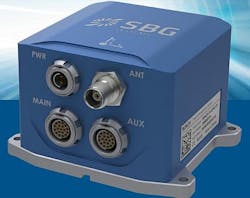Small size, light weight for unmanned vehicle applications dominate technology at SPIE
BALTIMORE, 2 May 2013. Tiny size, light weight, and low power consumption -- all with unmanned vehicles in mind -- were common themes this week at the SPIE Defense Security + Sensing electro-optics conference and trade show in Baltimore, as a wide variety of sensor integrators rolled out products for the newest generations of unmanned and soldier-worn technology.
Ranging from hyperspectral cameras, infrared sensors, and tiny inertial measurement units, exhibitors at SPIE Defense Security + Sensing were competing with one another for who could offer the smallest sensor packages with the most capability possible.
SBG Systems in Rueil-Malmaison, France, unveiled the Ekinox INS MEMS-based inertial navigation system (INS) that combines INS based on micro-electro-mechanical systems (MEMS) technology, with a miniaturized global positioning system (GPS) receiver for on-board navigation on unmanned aerial vehicles (UAVs), ground robots, and other small systems.
The Ekinox INS system also has an on-board enhanced Extended Kalman Filter and offers extended dynamic temperature calibration, aluminum enclosure, and galvanic isolated connectors for operation in harsh environments.
Company officials say the MEMS-based INS navigation system is for mid-and large-sized UAVs, avionics, laser radar, flight data recorders, unmanned underwater vehicles (UUVs), sonar systems, ship motion monitoring, and vehicle motion sensors.
The unit meets MIL-STD 810G for shock and vibration, and operates in temperatures from -40 to 85 degrees Celsius.
On the sensor side, Sensors Unlimited Inc. in Princeton, N.J., a unit of UTC Aerospace Systems, introduced the SU640CSX Micro-SWIR camera this week at SPIE Defense Security + Sensing.
The Micro-SWIR is a shortwave infrared (SWIR) video camera designed for applications requiring small, size, weight, and power (SWAP) such as UAVs and soldier systems. the unit has a 640-by-512-pixel format at 12.5 microns pitch, measures 1.25 cubic inches, and weighs slightly more than two ounces.
The tiny video camera has a 640-by-512-pixel high-sensitivity stabilized indium gallium arsenide (InGaAs) snapshot imager, and uses image-enhancement algorithms for quality imaging in all lighting conditions. The sensor is for daylight to low-light conditions.
In laser radar (lidar), Neptec Technologies Corp. in Kanata, Ontario, is introducing the OPAL-360-series obscurant-penetrating 3D lidar for harsh environments.
The OPAL-360 lidar is for autonomous off-road vehicles and robotics applications in harsh environments, as well as more conventional survey, mapping, and monitoring tasks. OPAL scanners can see through obscurants such as dust, smoke, or fog and are packaged to withstand the physical abuse of applications like mining, oil and gas, and construction.
OPAL sensors collect 3D data in 360 degrees in seconds using a non-overlapping scan pattern. The 2013 edition of the SPIE Defense Security + Sensing show wraps up today.

